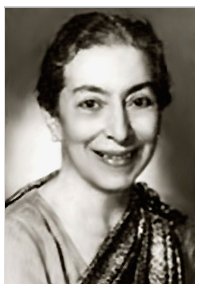Indian suffragists had an immense role to play both in the nationalist struggle and the subsequent universal adult franchise. One among them was Mithan Tata, one of the first women to be called to the English Bar and the first woman lawyer ever appointed to the Bombay High Court.
Unlike most large democracies, the Indian constitution has adopted universal suffrage from its inception. Indian suffragists deserve a significant share of the credit for this progressive cornerstone of independent India. Along with Madam Bhikaji Cama, Princess Sophia Duleep Singh, and Lolita Roy, Mithan Tata Lam too joined the women’s suffrage movement in British India.
Mithan Tata Lam (1898-1981) was born in Maharashtra to Ardeshir Tata and Herabai Tata. Her father worked as an employee in a textile mill, while her mother was a women’s rights activist. Mithan’s parents ensured that their daughter gets a well-rounded education, and sent her to reputed schools. She pursued her graduate studies at Elphinstone College, Bombay, where in she earned an honours degree in Economics. Her brilliant academic performance also won her the Cobden Club Medal.
Mithan’s mother, Herabai, had an immense role to play in her introduction to the suffrage struggle. Together, the mother-daughter duo achieved many firsts for Indian women. Herabai’s interest in Theosophy led her to make acquaintances with Annie Besant. In addition to being a theosophist, Besant was a prominent women’s rights activist and Indian self-rule supporter at the time. In 1911, Herabai met with suffragette Princess Sophia Duleep Singh. At the time of their meeting, Singh donned a badge that read, “Votes for Women.” Much like the words on the badge, Singh’s thoughts influenced Herabai’s understanding of the suffrage movement in India. She also interacted with other influential suffragists of the 20th century.
By 1915, Herabai had become the honorary secretary of the Women’s Indian Association. In 1919, Mithan joined her mother’s work as a suffragist. The duo travelled to London to present a memorandum on the women’s franchise, alongside Sarojini Naidu, before the Southborough Franchise Committee. The Committee was set up by the British in 1918. They sat in India for a year, and recommended a scheme of territorial urban and rural constituencies based on land revenue, communal and special interest representation.
The suffragists’ meeting with the Franchise Committee was to address the British government while the final readings of the Government of India Bill (1919) were being put through the British Parliament. The suffragists’ goal was to eliminate sex disqualification in the bill, which explicitly barred women in India from franchise. Mithan and Herabai’s statement – titled “Why Should Women Have Votes?” – was brought to the India Office on September 25th, 1919. Among their reasons for granting voting rights to women, Mithan and Herabai’s statement read:
“It has been recognised now in all countries that the sex barrier has been a grave mistake, is out of date, unworthy of the times, a relic of past days when might was above right … Why should India lag behind others in this respect and create a sex barrier where one does not exist, and thus brand Indian women as inferior to their sisters in other countries.”
They also argued,
“Attempt to reform without the cooperation of women, and you are simply raising a paper fabric on foundations of sand.”
Mithan, Herabai and other Indian suffragists succeeded in placing the rights of Indian women on a global platform. For this liberal cause, they brought together organisations and individuals from India and the United Kingdom. Though one nation was colonised by the other, individuals from both recognised their common goals in raising women’s presence and impact in the public sphere. In their support, suffrage organisations and individuals in Britain began sending letters to the India Office.
Unfortunately, these statements and petitions from Mithan and Herabai, as well as British suffragists proved to be unsuccessful. The Government of India Bill (1919) did not include women’s franchise. However, the British government did concede autonomy to individual Indian provinces to provide enfranchisement to women. These efforts by the suffragists led to the enfranchisement of women for the first time, in Madras in 1921.
The mother-daughter duo continued their stay in the United Kingdom. While Mithan pursued a post-graduate degree in economics and law at the London School of Economics, Herabai also enrolled in courses in administration, social sciences and economics at the institute, from 1919 to 1922. During the course of her studies in London, Mithan was one of the two students to be introduced to George V and Queen Mary. Mithan was also admitted to Lincoln’s Inn as a barrister in 1920 – only a year after Sex Disqualification (Removal) Act (1919) had allowed women to enter public office. In 1923, she became one of the first women to be called to the English Bar.
A year later Herabai and Mithan returned to India, where Mithan practiced at the Bombay High Court as the first woman lawyer in its history. She was also a professor of law at the Government Law College, making her the first woman to be a law professor in India.
Mithan described her time at the Bombay High Court as its lone female lawyer:
“Like a new animal at the zoo, with folks peeping through doorways…as soon as my shadow crossed from the library to the common room, there would be an uncomfortable silence, making me feel even more self-conscious.”
Interestingly, her first appearance at the Bombay High Court was fuelled by systemic misogyny. Reportedly, a solicitor whose client had a watertight case approached Mithan. He claimed about his client, “He has such a good case that he cannot lose…but he wants to inflict upon the opponent the humiliation of being defeated by a woman”.
Being the first of her kind, Mithan rallied against sexism within the legal profession by asking “how can a woman be declared unfit without even being given a trial?” Gender biases and misogyny within theoretical and professional disciplines is quite pervasive. Yet her efforts in the legal practice challenged the age-old hierarchies that thrive in courtrooms and public offices. These hierarchies are created and sustained by patriarchal powers, and Mithan led the way to dismantle those to the best of her ability. She is not only seen as a feminist icon but a liberal icon too, for her interventions in the legal sphere challenged and disrupted systemic misogyny. In doing so, they led to law becoming a more inclusive profession.
Soon, Mithan became a reputed name in the legal channels of Bombay, and worked on cases ranging from currency counterfeiters to Jewish betrothals. Outside the court, her liberal attitudes caused her to work extensively on gendered legislation for inheritance and marriage. She also became a popular advocate for women’s and children’s rights. Mithan was married to fellow lawyer, Jamshed Sorab Lam. He supported her work on the betterment of Bombay’s slum dwellers by improving health and infrastructure facilities.
After three years of practice at the Bombay High Court, Mithan Tata Lam was appointed as a Justice of Peace, and as a member of the committee on the Parsi Marriage Act (1865). Her contribution to the committee led to an amendment of the Act, i.e. the Parsi Marriage and Divorce Act (1936). Adding to her list of firsts, in 1947 Mithan became the first woman Sheriff of Bombay. She also chaired the Women’s Committee set up for the Relief and Rehabilitation of Refugees from Pakistan, in 1947.
She was also an active member of the All India Women’s Conference, and served as its president from 1961-62. The AIWC also ran a journal called Stri Dharma, and Mithan served as its editor for five years. She held leadership and representative positions in the National Council of Indian Women, the Women Graduates Union of Bombay, the Indian Federation of Women Lawyers, the International Federation of Women Lawyers, and the United Nations. For her efforts and contributions, she was awarded the Padma Bhushan in 1962, by the Government of India.
Mithan Tata Lam passed away in 1981, leaving behind an everlasting legacy that revolutionised legal, social, and political reform in India. What sets her apart from most of the liberal and feminist figures of her time is the kind of upbringing she had. Through her mother, Mithan was inducted into the struggles on women’s rights. Herabai also provided a bridge for her daughter to interact and be influenced by pioneers in the Indian suffragists movement. Her father, Ardeshir Tata is also credited for being far ahead of his time. To this day millions of women are denied an education, and yet in the early 20th century, Ardeshir helped his wife and daughter create a better future for themselves.
In 2021, we mark the 100 year anniversary of women first being enfranchised in Madras. The largest democracy in the world would not be what it is today without the consistent efforts and contributions of women such as Mithan Tata Lam. Hence, it is essential that we remember the efforts of the women who led the way for an inclusive and liberal society for the future generations of Indian women.


